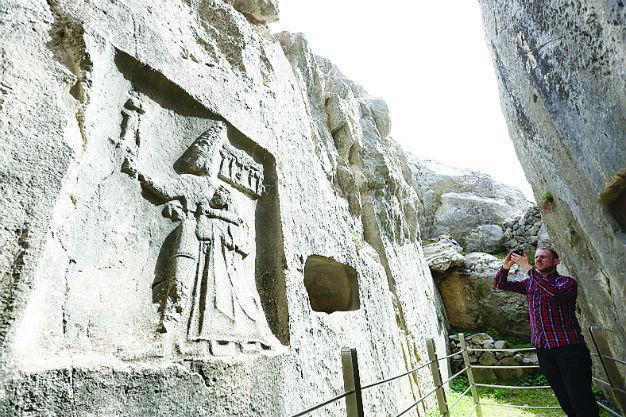The Hittite capital hosts ambassadors
ÇORUM – Anadolu Agency

AA photo
The archaeological site of Hattusha, the capital of the Hittite civilization which entered the UNESCO World Heritage list in 1986, was visited by a number of ambassadors in Turkey over the weekend as part of its two-day 30th anniversary celebrations organized by the governor’s office in the Central Anatolian province Çorum.
The ancient site is notable for its cuneiform inscriptions, one of the most important discoveries at the site, consisting of official correspondence and contracts, as well as legal codes, procedures for cult ceremonies, oracular prophecies and literature of the ancient Near East.
The cuneiforms entered the UNESCO Memory of the World list in 2001.
Within the scope of the celebrations, which also aimed at promoting Alacahöyük, a significant center of the Hittites, ambassadors also visited the Çorum Museum and examined artworks from the Hellenistic, Roman, Byzantine, Hittite, Phrygia, Chalcolithic and early Bronze Age eras as well as other things unique to the Central Anatolian province.
Located in Çorum’s modern-day Boğazkale district, Hattusha is surrounded by six kilometers of walls and considered one of Turkey’s the most important cultural values with its monumental gates, 31 unearthed temples, huge granaries and the Yazılıkaya Open Air Temple.
Only ancient city on two UNESCO lists
Hattusha, which is the only ancient city on both UNESCO lists, is also known as the city where the Kadesh treaty, the first written treaty in history, was signed between the Hittites and the Egyptians in 1280 B.C.
The first traces of settlements in Hattusha are in the form of small, short-lived village settlements found in the areas around the fields of Yarıkkaya, Büyükkaya and Çamlıbel.
The location, which is sheltered by deep valleys on either side and has many natural water sources, played an important role in the long urban development of Hattusha.
In its northern reaches, the city included a settlement of Assyrian merchants from northern Mesopotamia in the 19th and 18th centuries B.C. It developed like many other Bronze Age cities and shows oft-found characteristics in its architecture and urban layout.
The name “Hattush,” which means “silver” in Sumerian, is encountered on cuneiform documents for the first time in this period. The name of the city is thought to probably be associated with the silver trade.
Archaeological excavations have been ongoing in the ancient city as well as other important Hittite settlements, namely Alacahöyük, Şapinuva, Eskiyapar and Resuloğlu, and the unearthed artifacts are being displayed at the Çorum, Boğazköy and Alacahöyük museums.
Çorum Governor Ahmet Kara said the city was one of Turkey’s most important tourism spots but could not get the attention that it deserved because of a lack of promotion.
